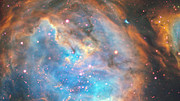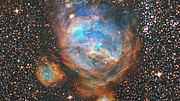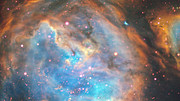Pressmeddelande
Bubblor kring nyfödda stjärnor
6 februari 2019
Detta färgsprakande område med nybildade stjärnor i Stora Magellanska molnet fotograferades med MUSE-instrumentet (Multi Unit Spectroscopic Exprorer) på ESO:s Very Large Telescope. Den relativt låga stofthalten i LMC gjorde det möjligt för MUSE att avslöja intrikata detaljer i synligt ljus.
Denna region i Stora Magellanska molnet (LMC) skiner i sprakande färger på denna bild som fångats med MUSE-instrumentet (Multi Unit Spectroscopic Explorer) på ESO:s Very Large Telescope (VLT). Vi ser här nebulosan LHA 120-N 180B, eller kort och gott N180 B. Det är en så kallad HII-region (uttalas "h två"), en födelseplats för stjärnor.
LMC är en satellitgalax till Vintergatan som syns bäst från södra stjärnhimlen och är osynlig från Sverige. På avståndet 160 000 ljusår är den bara ett kort kliv ut i den intergalaktiska rymden. HII-regionens närhet och läge i LMC:s enda spiralarm gör att vi kan studera den utan svårighet.
HII-regioner är interstellära moln av joniserat väte – de nakna kärnorna i väteatomer. De är födelseplatser för stärnor som joniserar den omgivande gasen och får den att lysa. N180 B får sitt säregna utseende av en enorm bubbla av joniserad vätgas , omgiven av fyra mindre.
Djupt inne i gasmolnet har MUSE hittat en jetstråle som avges av en purung stjärna med 12 gågner solens massa. Jetstrålen går under beteckningen Herbig-Haro 1177 (HH 1177) och visas i detalj i bilden intill. Eftersom unga stjärnor oftast göms i massiva moln av skymmande stoft har en jet av detta slag aldrig tidigare kunnat observeras bortom Vintergatan. Det är den relativt stoftfria interstellära rymden i LMC som gör det möjligt att studera HH 1177 i synliga våglängder. Jetstrålens längd är nästan 33 ljusår, vilket gör den till den längsta av sitt slag som har observerats.
HH 1177 berättar för oss om stjärnors tidiga liv. Jetstrålen är starkt kollimerad – strålen blir inte bredare när den rör sig bort från stjärnan, utan håller sig väl samlad. Jetstrålar som denna är kopplade till insamlingsskivor runt nyfödda stjärnor och kan ge insikter i hur de drar till sig materia från omgivningen. Astronomerna har funnit att både lätta och tunga nyfödda stjärnor ger upphov till kollimerade jetstrålar likt HH 1177 och att processerna är desamma. Det indikerar att massiva stjärnor kan bildas på samma sätt som sina lätta motsvarigheter.
År 2017 fick MUSE en avsevärd uppgradering i form av Adaptive Optics Facility som gjorde det möjligt avbilda ett större område av himlen. Med adaptiv optik kan ESO:s teleskop kompensera för luftoron och ta skarpa bilder med hög upplösning. Sedan denna bild på N180 B togs har MUSE dessutom uppgraderats med Narrow Field Mode. Det har mindre synfält men en skärpa som är i det närmaste lika hög som NASA/ESA:s rymdbaserade Hubbleteleskop. Nu har MUSE möjlighet att utforska universum med större detaljrikedom än någonsin tidigare.
Mer information
Dessa forskningsresultat presenterades i artikeln “An optical parsec-scale jet from a massive young star in the Large Magellanic Cloud” som publicerades i tidskriften Nature.
Forskarlaget utgjordes av A. F. McLeod (då vid University of Canterbury, Nya Zeeland och nu vid Department of Astronomy, University of California, Berkeley, och Department of Physics and Astronomy, Texas Tech University, USA), M. Reiter (Department of Astronomy, University of Michigan, Ann Arbor, USA), R. Kuiper (Institute of Astronomy and Astrophysics, University of Tübingen, Tyskland), P. D. Klaassen (UK Astronomy Technology Centre, Royal Observatory Edinburgh, Storbritannien) och C. J, Evans (UK Astronomy Technology Centre, Royal Observatory Edinburgh, Storbritannien).
Designen och konstruktionen av MUSE har pågått under en tioårsperiod inom MUSE-konsortiet som leds av Centre de Recherche Astrophysique de Lyon, Frankrike och partnerinstituten Leibniz-Institut für Astrophysik Potsdam (AIP, Tyskland), Institut für Astrophysik Göttingen (IAG, Tyskland), Institute for Astronomy ETH Zurich (Schweiz), L'Institut de Recherche en Astrophysique et Planétologie (IRAP, Frankrike), Nederlandse Onderzoekschool voor de Astronomie (NOVA, Nederländerna) and ESO.
ESO är Europas främsta mellanstatliga samarbetsorgan för astronomisk forskning och med råge världens mest produktiva astronomiska observatorium. Det har 16 medlemsländer: Belgien, Danmark, Finland, Frankrike, Irland, Italien, Nederländerna, Polen, Portugal, Schweiz, Spanien, Storbritannien, Sverige, Tjeckien, Tyskland och Österrike. ESO:s ambitiösa verksamhet rör design, konstruktion och drift av avancerade markbaserade forskningsanläggningar som gör det möjligt för astronomer att göra banbrytande vetenskapliga upptäckter. ESO spelar dessutom en ledande roll i att främja och organisera samarbeten inom astronomisk forskning. ESO driver tre unika observationsplatser i Chile: La Silla, Paranal och Chajnantor. Vid Paranal finns Very Large Telescope, världens mest avancerade observatorium för synligt ljus, och två kartläggningsteleskop. VISTA arbetar i infrarött ljus och är världens största kartläggningsteleskop och VST (VLT Survey Telescope) är det största teleskopet som konstruerats enbart för att kartlägga himlavalvet i synligt ljus. ESO är en huvudpartner i ALMA, världens hittills största astronomiska projekt. Och på Cerro Armazones, nära Paranal, bygger ESO det extremt stora 39-metersteleskopet för synligt och infrarött ljus, ELT. Det kommer att bli ”världens största öga mot himlen”.
Länkar
Kontakter
Anna McLeod
Postdoctoral Research Fellow — Texas Tech University & University of California Berkeley
Tel: +1 80 6834 2588
E-post: anna.mcleod@ttu.edu
Calum Turner
ESO Public Information Officer
Garching bei München, Germany
Tel: +49 89 3200 6670
E-post: pio@eso.org
Johan Warell (Presskontakt för Sverige)
ESO:s nätverk för vetenskaplig kommunikation
Skurup, Sverige
Tel: +46-706-494731
E-post: eson-sweden@eso.org
Om pressmeddelandet
| Pressmeddelande nr: | eso1903sv |
| Namn: | LHA 120-N 180B |
| Typ: | Local Universe : Nebula : Type : Star Formation |
| Facility: | Very Large Telescope |
| Instruments: | MUSE |
| Science data: | 2018Natur.554..334M |
Our use of Cookies
We use cookies that are essential for accessing our websites and using our services. We also use cookies to analyse, measure and improve our websites’ performance, to enable content sharing via social media and to display media content hosted on third-party platforms.
ESO Cookies Policy
The European Organisation for Astronomical Research in the Southern Hemisphere (ESO) is the pre-eminent intergovernmental science and technology organisation in astronomy. It carries out an ambitious programme focused on the design, construction and operation of powerful ground-based observing facilities for astronomy.
This Cookies Policy is intended to provide clarity by outlining the cookies used on the ESO public websites, their functions, the options you have for controlling them, and the ways you can contact us for additional details.
What are cookies?
Cookies are small pieces of data stored on your device by websites you visit. They serve various purposes, such as remembering login credentials and preferences and enhance your browsing experience.
Categories of cookies we use
Essential cookies (always active): These cookies are strictly necessary for the proper functioning of our website. Without these cookies, the website cannot operate correctly, and certain services, such as logging in or accessing secure areas, may not be available; because they are essential for the website’s operation, they cannot be disabled.
Functional Cookies: These cookies enhance your browsing experience by enabling additional features and personalization, such as remembering your preferences and settings. While not strictly necessary for the website to function, they improve usability and convenience; these cookies are only placed if you provide your consent.
Analytics cookies: These cookies collect information about how visitors interact with our website, such as which pages are visited most often and how users navigate the site. This data helps us improve website performance, optimize content, and enhance the user experience; these cookies are only placed if you provide your consent. We use the following analytics cookies.
Matomo Cookies:
This website uses Matomo (formerly Piwik), an open source software which enables the statistical analysis of website visits. Matomo uses cookies (text files) which are saved on your computer and which allow us to analyze how you use our website. The website user information generated by the cookies will only be saved on the servers of our IT Department. We use this information to analyze www.eso.org visits and to prepare reports on website activities. These data will not be disclosed to third parties.
On behalf of ESO, Matomo will use this information for the purpose of evaluating your use of the website, compiling reports on website activity and providing other services relating to website activity and internet usage.
Matomo cookies settings:
Additional Third-party cookies on ESO websites: some of our pages display content from external providers, e.g. YouTube.
Such third-party services are outside of ESO control and may, at any time, change their terms of service, use of cookies, etc.
YouTube: Some videos on the ESO website are embedded from ESO’s official YouTube channel. We have enabled YouTube’s privacy-enhanced mode, meaning that no cookies are set unless the user actively clicks on the video to play it. Additionally, in this mode, YouTube does not store any personally identifiable cookie data for embedded video playbacks. For more details, please refer to YouTube’s embedding videos information page.
Cookies can also be classified based on the following elements.
Regarding the domain, there are:
- First-party cookies, set by the website you are currently visiting. They are stored by the same domain that you are browsing and are used to enhance your experience on that site;
- Third-party cookies, set by a domain other than the one you are currently visiting.
As for their duration, cookies can be:
- Browser-session cookies, which are deleted when the user closes the browser;
- Stored cookies, which stay on the user's device for a predetermined period of time.
How to manage cookies
Cookie settings: You can modify your cookie choices for the ESO webpages at any time by clicking on the link Cookie settings at the bottom of any page.
In your browser: If you wish to delete cookies or instruct your browser to delete or block cookies by default, please visit the help pages of your browser:
Please be aware that if you delete or decline cookies, certain functionalities of our website may be not be available and your browsing experience may be affected.
You can set most browsers to prevent any cookies being placed on your device, but you may then have to manually adjust some preferences every time you visit a site/page. And some services and functionalities may not work properly at all (e.g. profile logging-in, shop check out).
Updates to the ESO Cookies Policy
The ESO Cookies Policy may be subject to future updates, which will be made available on this page.
Additional information
For any queries related to cookies, please contact: pdprATesoDOTorg.
As ESO public webpages are managed by our Department of Communication, your questions will be dealt with the support of the said Department.








